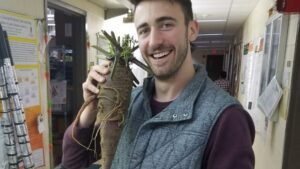Plant breeders realize and appreciate the importance of having access to an extensive set of germplasm for their breeding needs. Everyone is faced with new objectives in their program, be it for a new disease or insect resistance, or looking for novel nutritional traits, or simply to improve yield and resilience.
These days, most people include heat and drought tolerance among their objectives, and some of the materials in the germplasm system are potentially very excellent for that — especially some of the wild relatives of crop plants.
Our national germplasm system — accessed through the Germplasm Resources Information Network (or GRIN, found at ars-grin.gov) — has nearly 600,000 accessions representing more than 16,000 plant species of agricultural importance to the U.S. It’s an excellent resource that distributes germplasm around the world free of charge. It’s a credit to the USDA that they do this as a public service.
Through a search engine that lists all of the accessions in the GRIN system, you can find germplasm by species, variety name, and even plant introduction (PI) number. It offers a complete list of everything our national germplasm system has available.
Using the search engine, you can really narrow things down. In some cases, you could get trait data for, say, reaction to a particular disease of interest. Or you could get information on color of the seed or the flower.
Among the breeding community, there’s good awareness that the GRIN system is there, but among other members of the seed community, many don’t realize that the system even exists. For example, on my campus at Colorado State University (CSU), we have the USDA’s largest backup collection of seeds. It really is a gold mine. Many students and even staff who work at CSU don’t realize that the facility is there.

As a result, I’m happy to be part of an information project designed to raise awareness of the GRIN system, and therefore, to ensure continued support, both in terms of community involvement and financial contributions, to maintain and expand it.
Through our website found at GRIN-U.org, we have provided open access to educational and training content on plant genetic resources (PGR) conservation and use. The project is funded by a grant from the USDA National Institute of Food and Agriculture (NIFA), and includes investigators from ARS, Colorado State University, and Iowa State University.
As part of the GRIN family of products, GRIN-U contains audio-visual (videos, virtual tours, podcasts) and printed (e-books, infographics, manuals) materials on a variety of topics related to PGR management and plant gene bank operations.
Sustaining the network of gene banks that conserve PGR requires knowledgeable staff with skills in acquiring, maintaining, regenerating, evaluating, documenting, and distributing PGR accessions. The GRIN-U.org site is aimed at helping gene bank staff gain and enhance their skills in these areas. Information is also provided to guide plant breeders and geneticists in uncovering gene functions and incorporating useful genes into new varieties.
We need people to know about the importance of the GRIN system, and how continued funding is necessary to ensure it remains a viable tool that breeders can continue to benefit from.
It’s our hope that this site will raise awareness and help those who can use these resources — and also those in government who fund the GRIN system — to understand how critical our national gene bank system is, and how it needs to be maintained and strengthened to ensure plant breeders can create the crops that will feed the world of tomorrow.












